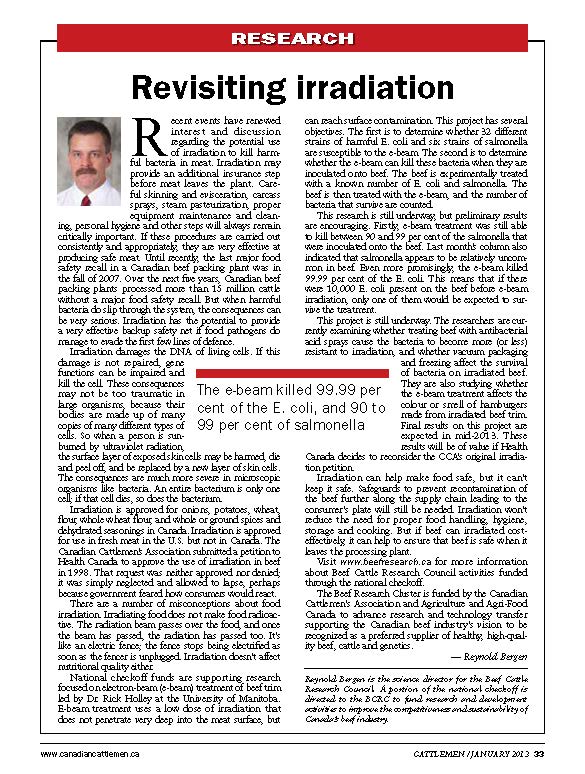Revisiting Irradiation
This article written by Dr. Reynold Bergen, BCRC Science Director, originally appeared in the January 2013 issue of Canadian Cattlemen magazine and is reprinted with permission.
Recent events have renewed interest and discussion regarding the potential use of irradiation to kill harmful bacteria in meat. Irradiation may provide an additional insurance step before meat leaves the plant. Careful skinning and evisceration, carcass sprays, steam pasteurization, proper equipment maintenance and cleaning, personal hygiene and other steps will always remain critically important. If these procedures are carried out consistently and appropriately, they are very effective at producing safe meat. Until recently, the last major food safety recall in a Canadian beef packing plant was in the fall of 2007. Over the next five years, Canadian beef packing plants processed more than 15 million cattle without a major food safety recall. But when harmful bacteria do slip through the system, the consequences can be very serious. Irradiation has the potential to provide a very effective backup safety net if food pathogens do manage to evade the first few lines of defence.
Irradiation damages the DNA of living cells. If this damage is not repaired, gene functions can be impaired and kill the cell. These consequences may not be too traumatic in large organisms, because their bodies are made up of many copies of many different types of cells. So when a person is sunburned by ultraviolet radiation, the surface layer of exposed skin cells may be harmed, die and peel off, and be replaced by a new layer of skin cells. The consequences are much more severe in microscopic organisms like bacteria. An entire bacterium is only one cell; if that cell dies, so does the bacterium.
Irradiation is approved for onions, potatoes, wheat, flour, whole wheat flour, and whole or ground spices and dehydrated seasonings in Canada. Irradiation is approved for use in fresh meat in the U.S. but not in Canada. The Canadian Cattlemen’s Association submitted a petition to Health Canada to approve the use of irradiation in beef in 1998. That request was neither approved nor denied; it was simply neglected and allowed to lapse, perhaps because government feared how consumer would react.
There are a number of misconceptions about food irradiation. Irradiating food does not make food radioactive. The radiation beam passes over the food, and once the beam has passed, the radiation has passed too. It’s like an electric fence; the fence stops being electrified as soon as the fencer is unplugged. Irradiation doesn’t affect nutritional quality, either.
National check-off funds are supporting research focused on electron-beam (e-beam) treatment of beef trim led by Dr. Rick Holley at the University of Manitoba. E-beam treatment uses a low dose of irradiation that does not penetrate very deep into the meat surface, but can reach surface contamination. This project has several objectives. The first is to determine whether 32 different strains of harmful E. coli and 6 strains of Salmonella are susceptible to the e-beam. The second is to determine whether the e-beam can kill these bacteria when they are inoculated onto beef. The beef is experimentally treated with a known number of E. coli and Salmonella. The beef is then treated with the e-beam, and the number of bacteria that survive are counted.
This research is still underway, but preliminary results are encouraging. Firstly, e-beam treatment was still able to kill between 90 and 99% of the Salmonella that were inoculated onto the beef. Last month’s column also indicated that Salmonella appears to be relatively uncommon in beef. Even more promisingly, the e-beam killed 99.99% of the E. coli. This means that if there were 10,000 E. coli present on the beef before e-beam irradiation, only one of them would be expected to survive the treatment.
This project is still underway. The researchers are currently examining whether treating beef with antibacterial acid sprays cause the bacteria to become more (or less) resistant to irradiation, and whether vacuum packaging and freezing affect the survival of bacteria on irradiated beef. They are also studying whether the e-beam treatment affects the color or smell of hamburgers made from irradiated beef trim. Final results on this project are expected in mid-2013. These results will be of value if Health Canada decides to reconsider the CCA’s original irradiation petition.
Irradiation can help make food safe, but it can’t keep it safe. Safeguards to prevent recontamination of the beef further along the supply chain leading to the consumer’s plate will still be needed. Irradiation won’t reduce the need for proper food handling, hygiene, storage and cooking. But if beef can irradiated cost-effectively, it can help to ensure that beef is safe when it leaves the processing plant.
We welcome your questions, comments and suggestions. Contact us directly at [email protected] or generate public discussion by posting your thoughts below.
Stay connected by following us on Twitter @BeefResearch, liking us on Facebook, and subscribing to our YouTube Channel.
Click here to subscribe and receive email notifications when new content is posted on the BCRC Blog.
